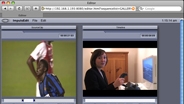Sienna partnership with Omneon speeds news editing

Gallery has been actively working with Omneon to integrate its Sienna news automation suite with Omneon’s MediaGrid active storage. “Automation Technology Update” spoke to Mark Gilbert of Gallery, co-developers with IEC of Sienna products, to find out more. “We showed an end-to-end media workflow for newsrooms with Omneon at IBC2009. It was a very good collaboration, and very well received,” Gilbert said.
Sienna has been looking at many of the shortcomings of media flows in the newsroom. “It’s been copy, copy, copy,” Gilbert said. “It’s not an efficient workflow … We have developed a single media workflow.” The Sienna/Omneon solution ingests directly to the MediaGrid. These can be edited in place on the server with Final Cut Pro seconds after the file ingest starts. “With no file transfers, the news workflow is accelerated,” he said.
The Sienna family of technologies is a fully integrated QuickTime and MOS-based news workflow, designed to be used with MOS news systems such as ENPS, alongside a Final Cut Pro-based QuickTime media infrastructure. Sienna’s PictureReady is a video capture application based on the Apple platform using AJA Kona video interface cards. The application is ideal for ingesting or capturing video and audio material directly to Omneon MediaGrid active storage. “Because PictureReady has a huge RAM cache, it can cope with network slowdowns,” Gilbert said, providing the reliable capture for news applications.
While PictureReady allows users to ingest content directly to the MediaGrid system, the Sienna MediaServices module automatically copies finished media from the MediaGrid system to Omneon Spectrum or MediaDeck server systems for active playout, even as the file transfer is underway. Sienna AutomationX — live assist automation, which is tied to the MOS newsroom system — provides playout control of the Spectrum and MediaDeck systems
Gilbert also shared details of a new product, ImpulsEdit. This cuts-only editor runs in a Web browser. The Web 2.0 application allows remote editing from a Mac or Windows platform for compatibility with a range of NRCSes. The edited story can either be aired directly or sent to Final Cut Pro for craft editing.
Gilbert identified some of the key requirements of news organizations. “Agencies and newsrooms are looking for intersite collaboration and globalizing their newsgathering,” he said. With pressure to reduce costs, if material can be edited from base, then savings can be achieved on travel and accommodation cost, especially for large events. ImpulsEdit also allows two people to collaboratively edit from two separate locations, sharing a sequence in real time. For example, the journalist may make a rough cut, and the news editor can view and refine that cut in collaboration, but from the other side of the world. Because the editing all takes place on the server, no copies are transferred; the ImpulsEdit clients just view a proxy.
In another example, a journalist at base can edit material shot at a remote event, and then transfer just the selected clips at broadcast resolution back to base, saving in backhaul bandwidth requirements “Log in to a faraway place,” Gilbert said, “and bring back the cuts you want.”
Get the TV Tech Newsletter
The professional video industry's #1 source for news, trends and product and tech information. Sign up below.
